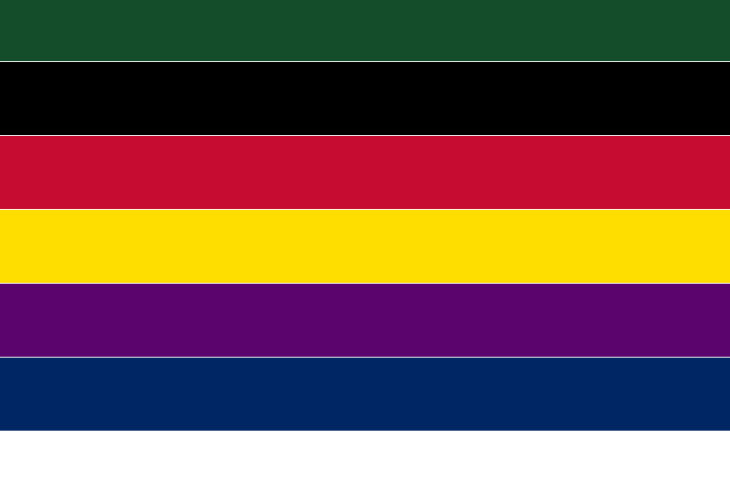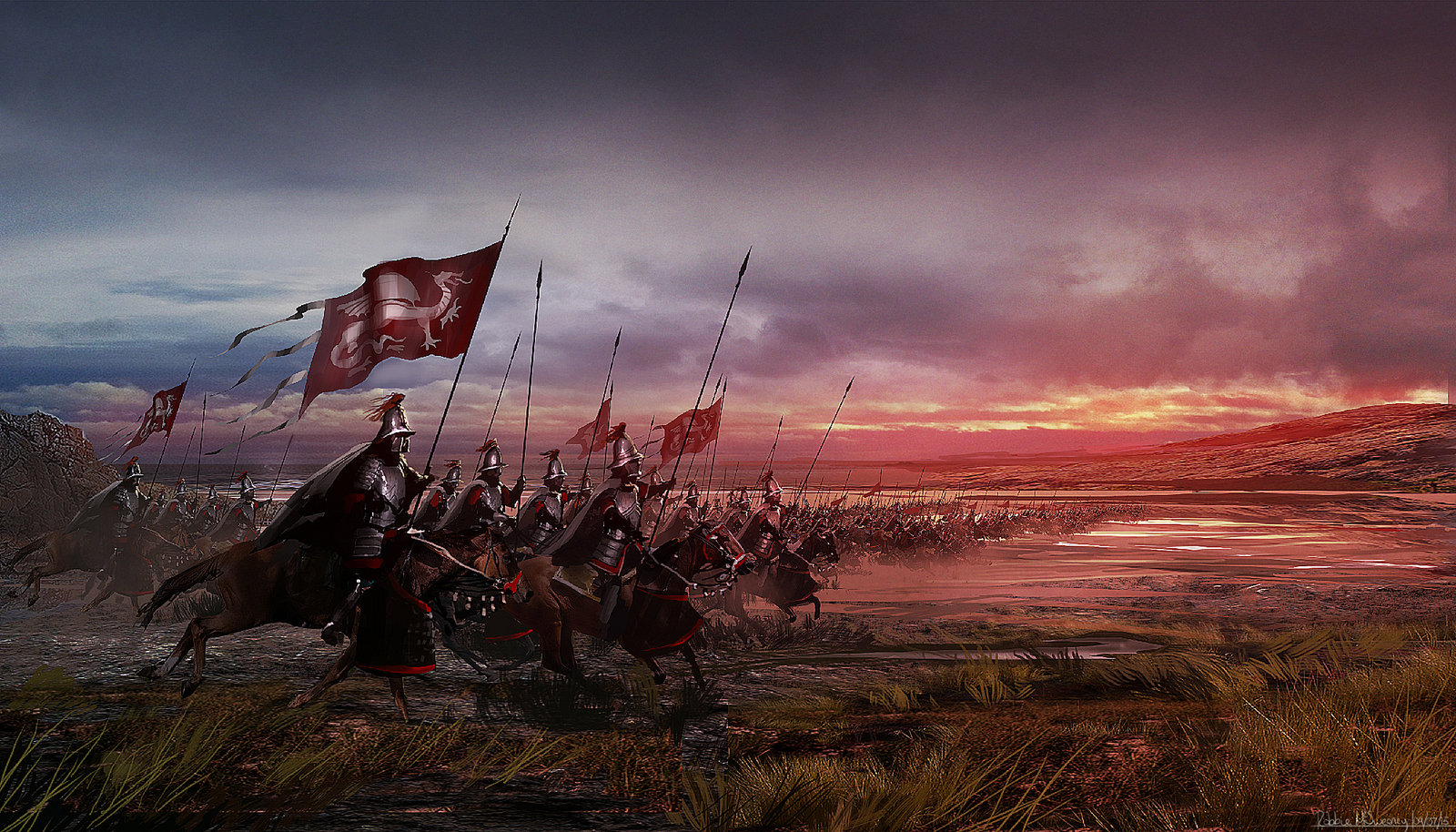Liúwáng Zhě
Descendants of militaristic extended hobgoblin families who were forced into exile from their homelands in Fuíguo by the expansion of Guandao, and later of the Terruk Mal, the Liúwáng Zhě have become a society defined by their role as elite mercenaries in western Galisea. Many bands however, see their exile in the west as a temporary situation, seeking an eventual return to their homeland. The Liúwáng Zhě are divided into several clans, which not only serve as extended families, but as mercenary companies, where all clan members who are capable of serving combat are trained to fight. They have become in the century since their exile, become some of the most well renowned mercenary bands in Western Galisea. Many clans are known for particular styles of fighting, or with certain wartime practices that allow them to distinguish themselves to prospective proposals. In the current time, there are a number of active groups that consider themselves to be part of the Liúwáng Zhě: Guìzú Lóng: Called by westerners, the Dragon Band, the Guìzú Lóng is the oldest, and most influential of the Liúwáng Zhě. They wre once also the largest, though their insistence on maintaining a relatively high level of cultural and racial purity has seen them lose this status to other, younger groups. With many of the leaders of the clan having claimed lineage from ancient dragons, the Guìzú Lóng have an unusually high number of spell casters in their number, something they use to great effect on the battlefield. Aside from this they have a fearsome reputation as an elite group with highly disciplined infantry, archers, and cavalry, not entirely unlike the royal armies of their homeland. Though they would like to retake Fuíguo, time and distance has slowly seen the revanchist tendencies of the Dragon Band fade over time.
Jïnxiù Yīng: Known also as the Majestic Eagle, the Jïnxiù Yīng are a skilled group of aerial cavalry. One of the smallest clans that are still active, the Jïnxiù Yīng are unique in that pretty much the entire clan is trained to ride aerial mounts into battle. Traditionally, they used to fly on mounts native to Fuíguo, though the generations spent in the western part of the continent has forced them to start flying Giant Eagles which are indigenous to the Odric Mountains. They are heavily revanchist, though they lack the numbers to actively engage in campaigns to retake their homes.
Guï Xióng: Known as the Ghost Bear, the Guï Xióng have a reputation for being some of the most brutally effective mercenaries around. Specializing in siege warfare, the Guï Xióng are known to be reluctant to take prisoners. Most Guï Xióng mercenaries are highly skilled shock troops able to storm fortifications and most are utterly devoted to their clan, with the company being willing to take heavy losses to achieve their objectives. The Guï Xióng, though having adapted well to the armaments and technique of Western Galisea, are one of those most active in their intent to retake their homeland.
Chán Hü: Also known as the Stalking Tiger, the Chán Hü are one of the smallest bands of the Liúwáng Zhě. They are a tight nit group, focusing on ancient monastic training that they had brought with them from their homeland. They have a well earned reputation for being expert ambushers, often stalking their targets for months before striking and utterly destroying them. They have tried to preserve their traditions to the greatest extent possible in their new environment, even as the conditions of Western Galisea have forced them to adapt with time.
Kuàisù Mílù: Called in the west, the Graceful Elk, the Kuàisù Mílù bring to bear, some of the fiercest and most elite cavalry mercenaries in western Galisea. They are renowned for their elan in battle, and are actively sought out for their ability to break even relatively well disciplined spear formations with brutal frontline charges. They have fully embraced the traditions of the west, adopting armors made by Aeillan and Gallacan smiths, and fighting as heavily armored lancers in contrast to their more traditional role as skilled horse archers.
Chán Láng: Also called the Howling Wolves, the Chán Láng are the largest and youngest of the clans that joined the Liúwáng Zhě diaspora. They are, for the Liúwáng Zhě, a relatively rowdy bunch, at least when off the battlefield. On the battlefield they generally prefer to engage in coordinated multi unit tactics to isolate, trap, and destroy enemy formations. Being descended from some of the last warriors to leave the homeland, they are also some of the poorest, and as a result their equipment is relatively light, and they lack horses, and as a result are largely light infantry.
Féishuò Niú: Known as the Band of the Ox by the west, the Féishuò Niú are another latecomer to the Liúwáng Zhě. They were some of the last peoples to have been conquered by the Terruk Mal, having held up in the mountains for years after the lowlands had been conquered. They have as a result, incorporated Bugbears, and Goblins into their clan to a much greater extent than the others, while also having adopted tactics that have made them some of the toughest soldiers, and most stalwart defenders that can be found in the west. They are staunch revanchists, and the leadership of the clan has actively been planning their return since being forced into exile, and Orcish peoples that they encounter are killed without hesistation.
Structure
The Liúwáng Zhě are a confederation of extended family groups, and as a result, the overall organization of the Liúwáng Zhě is very decentralized, with the only shared body between them being the occasional moot meant to resolve inter-clan conflict. In reality many clans have rivalries with other clans that occasionally boils over into open conflict, largely along feuds going all they way back to their homelands. Occasionally, a particularly strong willed and charismatic clan leader will establish themselves as Shìzú Müqīn of the whole of the Liúwáng Zhě, though they are often assassinated long before they can attempt to reunite the clans into one.
At a clan level, there is a more formal organization that traces its roots back to the extended family structures of Fuíguo. Each of the clans is headed by a Shìzú Müqīn, or Clan Mother, who is generally the eldest hobgoblin woman in the clan, though highly decorated members of the clan may instead take this place, who serves from their appointment, to their death, or their resignation. Underneath them are Jiātíng Müqīn elder hobgoblin women from smaller subgroups of the clan, who serve as family heads, and on the clan's council and as senior officers for the clan as an army. Beneath the Jiātíng Müqīn are a series of junior leaders, most often women, and predominantly hobgoblins, who are junior officers on the battlefield. At the lowest rungs are the average clan member who serve as soldiers, or as child minders if they survive to old age, and children. Every single clan, also has a champion, who is the clan's most skilled warrior, and who is called to serve in trial by combat when called upon by the moot, or to deal with enemy champions on the open battlefield.
Culture
The culture of the Liúwáng Zhě is largely preserved from Fuíguo, though the clans in fact hail from a specific, very militaristic subset of the Fuírén, which has caused a survivorship bias for martial traditions. As a rule, the clans of the Liúwáng Zhě favor courage and honor in battle, strong will, and an observation of certain rules civility when dealing with outsiders. Above all however, is the preservation of face, and appearing to be honorable, even if ones actual actions would indicate otherwise. The nature of the Liúwáng Zhě as mercenary bands has fundamentally challenged this notion however, as mercenary groups, in order to survive, must learn some capacity for capriciousness. The Liúwáng Zhě are a matriarchal society, with women holding most of the important leadership positions in the clans and where lineage is traced matrilinially, something seen as unusual by people living within Western Galisea where patriarchy, or rarely egalitarianism, predominating societies.
Public Agenda
The Liúwáng Zhě are Fuírén revanchists at heart, with most clans seeking a return to their traditional homeland, and the ousting of Guandao and the Terruk Mal from those lands. Where individual clans differ is in commitment to this overarching objective, with some clans, such as the Guï Xióng, and the Féishuò Niú being aggressive in their desire for revenge, but others, such as the Chán Láng holding a lesser commitment to the reclamation of Fuíguo. As mercenary companies however, all clans possess a short term goal of seeking contracts and making the money necessary to survive as a group, and to procure better equipment for their members.
History
Founded after the the fall of Shandao during the Conquests of Empress Zháng Zhàotän, the Liúwáng Zhě were initially composed of the three matron clans, the Guìzú Lóng, the Jïnxiù Yīng, and the Kuàisù Mílù, who each vowed revenge against the humans, who had overrun the jewel of the Fuíguo. From their bases in the western half of the nation, they had launched numerous attempts at a hobgoblin reconquista of the territory, each of which failed. These failed attempts further weakened the Fuí state, enabling conquest of most of the remainder of the country by the Terruk Mal.
With most of their home taken, the three matron clans, were joined by the Guï Xióng and the Chán Hü as they went into exile, slowly moving west over several decades, and taking on mercenary work, largely fighting against the expansion of the Terruk-Mal as they themselves began to turn their attention westward. Eventually they found themselves west of the Nabari Plateau, having been chased out of that region themselves, by the Aarumites who had also fled from Terruk expansion. There they found plenty of work fighting on behalf of nobles in the decaying state of Gallaca, and the largely demilitarized societies in Elleryca.
Since establishing themselves in the western part of the continent, the Liúwáng Zhě have steadily built up a reputation for serving as top notch mercenaries in southwest Galisea, with each company suiting different interests. They have become the deciding factor in a number of conflicts in the region, particularly in Gallaca, where the introduction of Fuírén mercenaries is seen as a major escalation of force in the petty squabbles of the nobility. They have since been joined by the last two clans to be ejected from the homeland the Chán Láng and the Féishuò Niú. Though for most, the dream of retaking the homeland has never fully died, the current political reality of their situation has seen revanchist tendencies start to die down in some of the less radical clans, and indeed, some have started to consider the possibility of carving out new homelands as Gallaca slowly disintigrates from internal rot, and the Elleryc people prove passive in the face of danger.

To restore our homes and honor
Founding Date
YF 1561
Type
Geopolitical, Clan
Alternative Names
The Fuilan Clans, The Clans, The Ghost Kingdom
Training Level
Professional
Veterancy Level
Decorated/Honored
Demonym
Fuírén
Leader Title
Location
Related Ranks & Titles
Related Ethnicities



